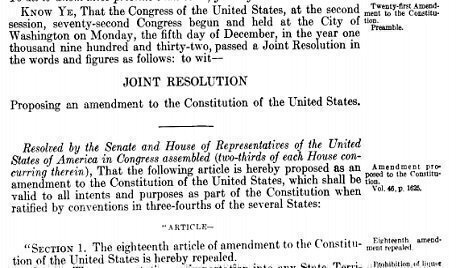:max_bytes(150000):strip_icc()/Preamble-58b5de0b3df78cdcd8deb0f4.jpg)
A current public debate started by a retired Supreme Court Justice has people talking about possibly repealing one of the Constitution’s original 10 amendments. In reality, the odds of such an act happening are extremely long.
 Justice John Paul Stevens’ Tuesday op-ed in the New York Times called for a repeal of the Second Amendment, which guarantees “a well regulated Militia, being necessary to the security of a free State, the right of the people to keep and bear Arms, shall not be infringed.”
Justice John Paul Stevens’ Tuesday op-ed in the New York Times called for a repeal of the Second Amendment, which guarantees “a well regulated Militia, being necessary to the security of a free State, the right of the people to keep and bear Arms, shall not be infringed.”
Stevens didn’t offer an alternative to the Second Amendment in his Times piece, but in his 2014 book, the Justice wanted the amendment rewritten to only pertain to state militias.
Changing the actual words of the Constitution does take an amendment, as does actually deleting, or repealing, an amendment. Including the first 10 amendments, the Bill of Rights, which were ratified in 1789, the Senate historian estimates that approximately 11,699 amendment changes have been proposed in Congress through 2016. Only one amendment, the 18th Amendment that established Prohibition, was later repealed by the states.
In simple odds, the chance of any constitutional amendment being repealed would be roughly the same as a person living to 80 years old being struck by lightning during their lifetime, according to National Weather Service data. And for the Second Amendment, which was rooted in the English Declaration of Rights a century before the Bill of Rights was ratified, the odds would likely be steeper.
In recent years, three other amendments have been subject of repeal talk: the 17th Amendment (the direct election of Senators), the 16th Amendment (the federal income tax), and the 22nd Amendment (presidential term limits). None of that talk came close to fruition.
The Constitution’s Article V requires that an amendment be proposed by two-thirds of the House and Senate, or by a constitutional convention called for by two-thirds of the state legislatures. It is up to the states to approve a new amendment, with three-quarters of the states voting to ratifying it.
The one instance of an amendment appeal, the 21st Amendment, shows how this unusual process works. The 18th Amendment ratified in 1919 prohibited “the manufacture, sale, or transportation of intoxicating liquors” nationwide under most circumstances. By the early 1930s, Prohibition had become unpopular and Congress passed the 21st Amendment, with its repeal provision, in February 1933 just before Franklin Roosevelt became President. The amendment proposed for ratification included language never used before but permitted under Article V: state conventions (and not state legislatures) would be called for ratification votes, out of fear the temperance lobby would influence state lawmakers.
When Utah became the 36th state to approve the amendment in December 1933, the ratified 21st Amendment not only repealed the broad prohibition on alcohol, it also added language to the Constitution that states had the ability to define alcohol laws within their borders.
The most-recent amendment added to the Constitution was the 27th Amendment in 1992, which prevented Congress from changing its own compensation during a term in progress; that amendment had first been proposed in 1789 but wasn’t ratified as part of the Bill of Rights. Six amendments have been approved by Congress but never fully ratified by the states, with the District of Columbia Voting Rights amendment that last one that failed to get approval in 1985.
Scott Bomboy is the editor in chief of the National Constitution Center.
